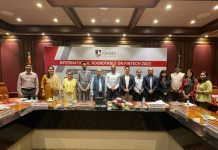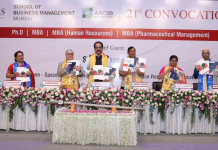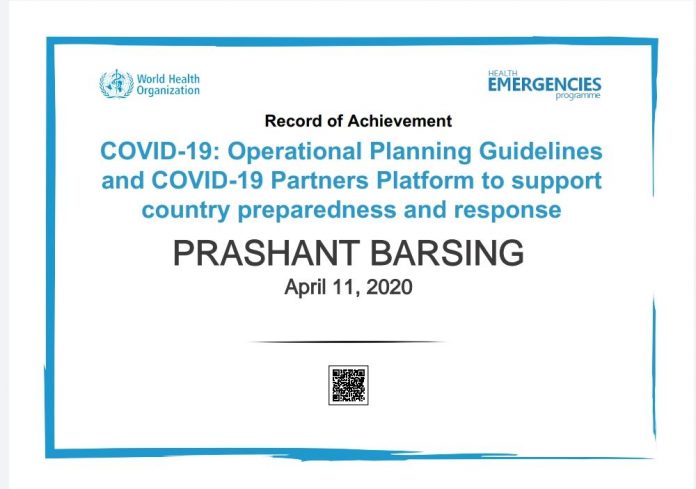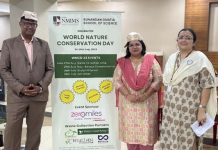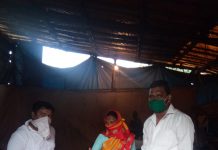COVID-19 is becoming a challenge to India because of its rapid spread due to its human to human contact. Being a 1.38 Billion populated county, human to human contact is very often, and if not avoided, then it will be highly disastrous. India’s as the healthcare system is not able to handle such disaster; therefore, initially, three weeks complete lockdown was declared by the government and then again extended for another three weeks due to its spread. Initially, due to lack of testing measures, cases were not identified quickly, and people were not coming forward to get tested. As testing has taken speed, many cases came into light. Due to lockdown and social distancing, the rapid spread seems to be controlled.
As a researcher in the area of Humanitarian Logistics and Disaster Management, I came across World Health Organizations (WHO) module on COVID-19: Operational Planning Guidelines and COVID-19 Partners Platform to support country preparedness and response. As India is the second highly populated country and diverse geographically, it is prone to Natural as well as man-made disasters. The article is about the actions and measures taken by the government. It is discussed in the frame provided by the WHO.
In order to assist preparedness and response to COVID-19, WHO has developed, learning modules as a companion to the Operational Planning Guidelines to Support Country Preparedness and Response.
The training is intended:
*For UN country teams (UNCTs)
*For other relevant stakeholders, including partners, donors and civil society
*To support national readiness and preparedness for COVID-19
*To help countries increase their capacity to respond to COVID-19
*To improve international coordination for response and preparedness
*To streamline the process of coordinating resources and assessing country preparedness level
Pillars of the public health response to the India perspective:
Pillar 1: Country-level coordination, planning and monitoring
On 24 March 2020, India shut its $2.9 trillion (£2.3tn) economy, closing its businesses and issuing strict stay-at-home orders to more than a billion people. Air, road and rail transport systems were suspended. Only essential services are allowed. The Central Government and States are closely monitoring the spread of the virus. Central has imposed strict measures regarding the movement of people. States have taken responsibility for taking care of people by providing them with temporary shelters and food. Also, arranged groceries and ration to the public. Central and States divided responsibilities to have minimal impact on the people.
Pillar 2: Risk communication and community engagement
Central and State Governments are continually engaging with people through media and spreading awareness. Also, declared complete lockdown as mentioned earlier and extended till 3 May 2020.
Ayush (https://www.ayush.gov.in/) under the Health Ministry has given some guidelines to increase one’s immunity and How to take person-level hygiene to combat infection. Another measure taken is the launch of Arogya Setu app. This app not only helps you to understand symptoms but also aware of test facilities and nearby suspects of infection through Bluetooth. The awareness material is being published by the Ministry on their website (https://www.mohfw.gov.in/index.html)
Pillar 3: Surveillance, epidemiologic investigation, rapid-response and case investigation
The cases which have found in other countries are due to lack of stress at the initial stage. Therefore, the government is focusing mainly on testing of suspects. The person who has abroad travel history is kept for 14 days of compulsory quarantined. Also, if someone Is in contact with the person who has travel history as well as the confirmed case, is retained for 14 days quarantine. The stamp on hand confirms the same and if someone found violating this is warned and taken action against such person. Disaster Management Act is in force in all districts of India. Under this, the government has acquired facilities to build isolation centers as well as facilities for health care workers and medical staff. Depend on spread HOTSPOT areas have identified and strict observations observed for the same. As per cases, the area has classified as Red, Orange and Green to keep focus. Once the case is confirmed in some area, the entire area is sealed, and surrounding area people got tested frequently for symptoms or asymptomatic people.
Pillar 4: Points of entry
The entry of COVID-19 is through travellers who have visited the infected area or came in contact with an infected person abroad. Therefore, the air travels as well as road, sea travel has completely shut down. The entry is restricted to land and entry in India. Borders have sealed for foreign traveller. In India, all states have closed borders and districts also advised to seal borders. The metro rail, railways, inter and intrastate bus transport services have entirely shut down. Section 144 imposed, and no more than five people are allowed to gather. Also, the Ministry advised wearing a mask to every person moving out for any reason. All travel related advisories can be found on ministry websites.
Pillar 5: National laboratories
Ministry of Health and Family Welfare has taken cognizance of COVID-19 and issued guidelines to national laboratories. Government has asked private labs to conduct the test and provide data to the government. Supreme Court advises to keep testing fees minimal and to be taken from those who can pay. Ministry of Health and Family Welfare is continuously publishing testing data received from laboratories. The Indian Council of Medical Research (ICMR), New Delhi, the apex body in India for the formulation, coordination and promotion of biomedical research, is one of the oldest medical research about COVID-19. Hospitals admitting suspect cases of COVID19 should collect nasal and throat swab samples in one VTM tube and transport them to the nearest testing laboratory in the cold chain. The list of Government and Private laboratories with COVID19 testing facility can be accessed by clicking the link: https://covid.icmr.org.in/index.php/testing-facilities
Pillar 6: Infection prevention and control
As discussed earlier, the infected person found after testing or having contact with infected person is isolated or quarantined from the mainstream population. Many hospitals have made separate COVID-19 units to take care of such patients. Wearing a mask is compulsory for all and has to maintain social distancing while moving out. Many district administrations allow essential services for a particular time of the day to avoid minimum contact. Also, home delivery options for housing societies is made easier to avoid contacts. Ecommerce companies are delivering only essential goods keeping social distancing in mind. All public places of worships, functions, ceremonies and events where people may gather are closed down, and permission for such gathering of any kind is denied. Even the funeral of the deceased of COVID-19 is not allowed more than few to avoid infection. To control the spread, many areas declared hotspot and movement is restricted. More emphasize is given on the testing of such regions to identify the possible infected person. Healthcare workers have provided with PPE kits and mask to avoid any infection while working. The Police and another person who is maintaining law have equipped with Sanitization Van and facilities to have any kind of disease during duty hours.
Pillar 7: Case management
The reported cases give the idea of virus spread. As we discussed earlier, the areas have been classified into different zones based on the number of cases. It has been seen that person with no other medical condition is at low risk than who have some or other medical condition such as heart disease, respiratory issues, diabetes, kidney issues etc. Also, the age group plays an essential factor as immunity is age-related phenomena mostly. Keeping this factor in mind, those critical or severe cases given priority over mild cases, also, in case of expecting or lactating woman or child given priority to treat. To help identify lab facilities, nearby lab testing data is produced and displayed at measure points in cities and other vital areas. Once, the area is notified, then an ambulance and other medical services got prepared to other cases if any arising from that area in the near future.
Pillar 8: Operations support and logistics
In the period of lockdown, people are struggling to meet the need of essential supplies. The government is assuring citizens to not to worry and stock the quantities as it will be provided when needed. Government (state and central) is providing subsidized food and other items at rationing stores. Also, essential goods and services are not locked down; hence people can have access to it when needed. Those who are unable to fly home due to lockdown, the state governments have created temporary shelters at schools and some suitable places and provided with food needs till lockdown period is over. As far as supplies of medical equipment’s and gears is considered, then governments asked many private firms to provide them with ventilators and masks. The medicines such as Hydroxychloroquine supplies also managed, and extra stocks can be delivered to other countries when needed. Many public sector units (PSU) and private firms are working together to meet the demand for urgent supplies at the earliest to fight with COVID-19.
Brief about the author: My area of research is Humanitarian Logistics and Disaster Management. I have worked with Govt of UP and Bihar during flood times. Bihar State Disaster Management Authority (BSDMA) have provided the opportunity to understand problems with floods in the state. Also, NIDM and NDMA provided learnings about disaster management. I have published a few papers on this and awarded Best Paper Award for my research. I teach Statistics, Business Analytics and Operations Management for PGDM.
Prof. Prashant Barsing (MTech-IIT Kanpur, FPM: IIM Lucknow)
Assistant Professor
Operations and Quantitative Techniques (OM&QT),
School of Business Management (SBM)
NMIMS Navi Mumbai





